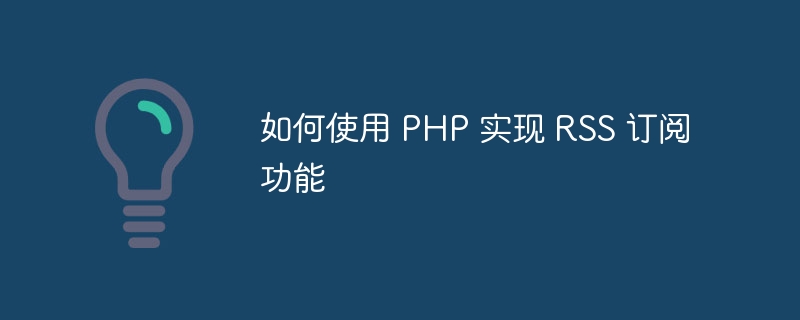How to use PHP to implement RSS subscription function

How to use PHP to implement RSS subscription function
RSS (Really Simple Syndication) is a format for publishing and subscribing to website updates. Using RSS, users can easily obtain the latest information from websites that interest them without having to visit the website regularly. In this article, we will learn how to implement RSS subscription functionality using PHP.
First, we need to understand the basic structure of RSS. A typical RSS document consists of one or more items, each item represents an article or a topic. Each item contains key information such as title, link, publication date, description, and more. In PHP, we can use SimpleXML class to parse RSS documents.
Next, we need to write a function to get the content of the RSS feed. This function will use PHP's file reading capabilities to download the RSS document and return the parsed SimpleXML object. Here is a basic example:
function getRSSContent($url) {
$xml = file_get_contents($url);
$rss = simplexml_load_string($xml);
return $rss;
} In the above code, we have used the file_get_contents function to download the contents of the RSS document and the simplexml_load_string function to Parsed into a SimpleXML object. We then return this object for use in subsequent operations.
Now, we can write a function to display the content of the RSS feed. This function will receive the URL of an RSS feed as a parameter and output all items from that feed. The following is an example:
function displayRSS($url) {
$rss = getRSSContent($url);
foreach ($rss->channel->item as $item) {
echo '<h3>'.$item->title.'</h3>';
echo '<p>'.htmlspecialchars_decode($item->description).'</p>';
echo '<a href="'.$item->link.'">阅读更多</a>';
echo '<hr>';
}
}In the above code, we first called the getRSSContent function to obtain the content of the RSS source. We then use foreach to loop through each item and output the title, description, and link information. Please note that we use the htmlspecialchars_decode function to decode the HTML entities in the description to ensure correct display.
Finally, we can call the displayRSS function on the page to display the content of an RSS source. Here is an example:
$url = 'http://example.com/rss.xml'; displayRSS($url);
The above code will display all items of the RSS feed named http://example.com/rss.xml.
To sum up, by using PHP's SimpleXML class and related functions, we can easily implement the RSS subscription function. We can write a function to get the contents of an RSS feed and another function to display items from a specific RSS feed. In this way, we make it easy for users to subscribe and get updates from websites that interest them.
The above is the detailed content of How to use PHP to implement RSS subscription function. For more information, please follow other related articles on the PHP Chinese website!

Hot AI Tools

Undresser.AI Undress
AI-powered app for creating realistic nude photos

AI Clothes Remover
Online AI tool for removing clothes from photos.

Undress AI Tool
Undress images for free

Clothoff.io
AI clothes remover

AI Hentai Generator
Generate AI Hentai for free.

Hot Article

Hot Tools

Notepad++7.3.1
Easy-to-use and free code editor

SublimeText3 Chinese version
Chinese version, very easy to use

Zend Studio 13.0.1
Powerful PHP integrated development environment

Dreamweaver CS6
Visual web development tools

SublimeText3 Mac version
God-level code editing software (SublimeText3)

Hot Topics
 CakePHP Project Configuration
Sep 10, 2024 pm 05:25 PM
CakePHP Project Configuration
Sep 10, 2024 pm 05:25 PM
In this chapter, we will understand the Environment Variables, General Configuration, Database Configuration and Email Configuration in CakePHP.
 PHP 8.4 Installation and Upgrade guide for Ubuntu and Debian
Dec 24, 2024 pm 04:42 PM
PHP 8.4 Installation and Upgrade guide for Ubuntu and Debian
Dec 24, 2024 pm 04:42 PM
PHP 8.4 brings several new features, security improvements, and performance improvements with healthy amounts of feature deprecations and removals. This guide explains how to install PHP 8.4 or upgrade to PHP 8.4 on Ubuntu, Debian, or their derivati
 CakePHP Date and Time
Sep 10, 2024 pm 05:27 PM
CakePHP Date and Time
Sep 10, 2024 pm 05:27 PM
To work with date and time in cakephp4, we are going to make use of the available FrozenTime class.
 CakePHP File upload
Sep 10, 2024 pm 05:27 PM
CakePHP File upload
Sep 10, 2024 pm 05:27 PM
To work on file upload we are going to use the form helper. Here, is an example for file upload.
 CakePHP Routing
Sep 10, 2024 pm 05:25 PM
CakePHP Routing
Sep 10, 2024 pm 05:25 PM
In this chapter, we are going to learn the following topics related to routing ?
 Discuss CakePHP
Sep 10, 2024 pm 05:28 PM
Discuss CakePHP
Sep 10, 2024 pm 05:28 PM
CakePHP is an open-source framework for PHP. It is intended to make developing, deploying and maintaining applications much easier. CakePHP is based on a MVC-like architecture that is both powerful and easy to grasp. Models, Views, and Controllers gu
 CakePHP Creating Validators
Sep 10, 2024 pm 05:26 PM
CakePHP Creating Validators
Sep 10, 2024 pm 05:26 PM
Validator can be created by adding the following two lines in the controller.
 CakePHP Working with Database
Sep 10, 2024 pm 05:25 PM
CakePHP Working with Database
Sep 10, 2024 pm 05:25 PM
Working with database in CakePHP is very easy. We will understand the CRUD (Create, Read, Update, Delete) operations in this chapter.






